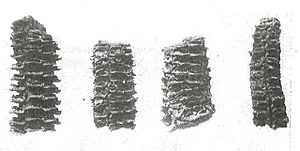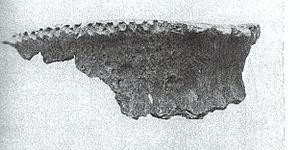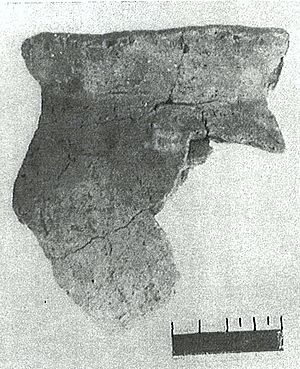Moccasin Bluff Site facts for kids
Quick facts for kids |
|
|
Moccasin Bluff Site
|
|
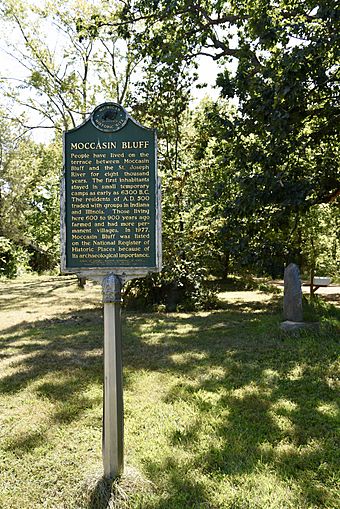 |
|
| Location | Red Bud Trail near Buchanan, Michigan |
|---|---|
| Area | 5 acres (2.0 ha) |
| NRHP reference No. | 77000710 |
| Added to NRHP | April 13, 1977 |
The Moccasin Bluff Site (also called 20BE8) is an archaeological site in Michigan. It's located along Red Bud Trail and the St. Joseph River, just north of Buchanan, Michigan. This important site was added to the National Register of Historic Places in 1977.
Archaeologists have found evidence of many different groups of people living here over thousands of years. The main period of activity was during the Late Woodland and Upper Mississippian times.
Contents
- A Look Back: History of Moccasin Bluff
- What is the Moccasin Bluff Site?
- Discoveries from the 1948 Digs
- New Discoveries from the 2002 Digs
- How Was Moccasin Bluff Used?
A Look Back: History of Moccasin Bluff
The land near Moccasin Bluff and the St. Joseph River was a popular spot for temporary camps as early as 6300 B.C. Around A.D. 500, the people living here traded with other Native American groups from places like Illinois and Indiana.
By A.D. 1100-1400, more permanent villages were built. The people who lived here started farming the land.
In the late 1820s, European settlers began moving into the area. They came to cut down trees and farm the land. The U.S. government then decided to move the local Potawatomi people further west. The bluff is believed to be named after Cogomoccasin, a leader from one of these Potawatomi villages.
Archaeologists have studied the site several times. In 1948, a team from the University of Michigan dug here. They found pottery, burials, and remains of maize (corn) and storage pits. Later, in 2002, Michigan State University explored a wetland area nearby.
What is the Moccasin Bluff Site?
The Moccasin Bluff Site sits on a flat area (a terrace) next to Red Bud Trail. This terrace offers a great view of a wide bend in the St. Joseph River, which has two islands. Hills protect the site from the north, west, and south.
This site is very important because it shows a long history of people living there. It's one of the few places in western Michigan with so much evidence of ancient life. This means there's a rich "midden" (a fancy word for an ancient trash heap) filled with many artifacts.
Even though the layers of dirt aren't perfectly separated, the artifacts themselves, along with radiocarbon dating, tell us about different periods. These periods range from about 8500 BC to the 1600s A.D., just before Europeans arrived.
Archaeologists found items from the Archaic (c. 8500-1500 BC), Early Woodland (c. 1500-100 BC), and Middle Woodland (c. 100 BC-500 AD) periods. However, most of the activity happened during the Late Woodland period (c. 500-1500 AD). There's also evidence of Upper Mississippian people (c. 1000-1500 AD) living here or having an influence.
Discoveries from the 1948 Digs
The excavations in 1948 uncovered many interesting things. These included ancient pits, Prehistoric artifacts, animal bones, and plant remains.
What Did Archaeologists Find?
Archaeologists didn't find any clear signs of dwellings or houses at the site. They also didn't find "post molds," which are marks left in the ground by old wooden posts that would have supported structures. Researchers think that the main part of the site, where houses might have been, was destroyed when the Red Bud Trail Highway was built.
They did identify four types of pits:
- Storage pits (62 of them) were used to store food.
- Fire pits (17 of them) were used for cooking.
- Hearths (19 of them) were also used for fires.
- Smudge pits (2 of them) had a special purpose.
Three burials were also found, but only one was fully dug up.
The fire pits might have been like earth ovens. They could have been used to roast the tubers (underground stems) of white water lilies. While no lily tubers were found here, similar pits at other sites in Indiana and Michigan contained charred remains of water lily or American Lotus tubers.
Both smudge pits contained charred maize (corn). After studying the corn, experts determined it was "Eastern Complex maize." Based on old observations of Native American tribes, researchers believe these pits were used to create smoke (smudge) to cure animal hides.
Animal Bones and What They Tell Us
Archaeologists found bones from 32 different animal species at Moccasin Bluff. When they figured out how much meat each species provided, they found:
These bones were not made into tools. They were likely food remains. The dog and bear bones might also be from special ceremonies. Some early Native American tribes had ceremonies that involved dog meat or bear worship.
Ancient Plant Remains
Pieces of wood charcoal from the fire pits were studied. They were mostly oak, hickory, and maple, which shows what the local deciduous forest was like. Some charred food remains were also found, including acorns, walnuts, Canadian plums, butternuts, and hickory nuts. The Eastern Complex maize was found in the two smudge pits.
Artifacts: Tools and Treasures
Many different types of artifacts were found at the site:
- Pottery: No complete pots were found. So, researchers mainly looked at rim pieces and unique body pieces. They found 534 analyzable rim pieces, representing at least 424 different pots! We'll talk more about pottery below.
- Stone Tools: There were 1,519 stone tools, tool fragments, and flakes. They also found hammer stones, anvil stones, celts (like axes), and grinding stones.
- Bone tools: These included bone cylinders, tools for working hides, antler tools, bone awls (for piercing), elk scapula (shoulder blade) tools, and turtle carapaces (shells). A piece of a bone rasp (a musical instrument) was also found in a collection donated by a local person.
- Stone Pendants: Two pieces of stone with holes in the middle were found. They were likely worn as pendants.
- Pipes: Six fragments of pipes or unfinished pipe bowls were found. They were made of clay or stone.
- Red Ochre: Seven pieces of red ochre (a natural pigment) were found.
Non-pottery artifacts help us understand the daily life, ceremonies, games, and clothing of the people who lived here.
Here are some of the most important non-pottery artifacts:
| Material | Description | Image | How Many? | What Was It Used For? | Interesting Facts |
|---|---|---|---|---|---|
| Chipped Stone | Small Triangular Points (aka Madison Points) | 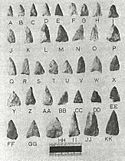 |
104 (44% of all chipped stone tools) | Hunting, fishing, or fighting | Also called “arrowheads”. They were likely tips for bows-and-arrows. Bows and arrows became much more common during the Late Woodland period, perhaps because of more conflicts. Since a lot of sturgeon fish bones were found, these tools were probably used for fishing too. |
| Chipped Stone | Ovate or double pointed blades/knives | 3 | Cutting for daily tasks | Some show signs of being attached to a handle. These are typical of Upper Mississippian sites. | |
| Chipped Stone | Bifacially flaked end scraper |  |
22 | Preparing wood or animal hides | Common at Oneota sites, but usually flaked on only one side, not both. |
| Chipped Stone | Drills |  |
6 | Drilling holes in wood or hides | Three types were found: double pointed, expanded base (both common), and T-shaped (pictured), which is often found at Fort Ancient sites. |
| Chipped Stone | Thick "steep-edge" blades/scrapers | 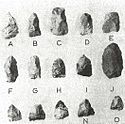 |
53 | Working with wood | Also found at Fisher-Huber sites in Illinois. |
| Stone | Abraiding stone | 1 | Straightening arrow shafts | Considered a typical Upper Mississippian tool. | |
| Antler | Spatula pieces of antler; Chisel/gouge/scraper | 5 | Unknown specific use for daily tasks | Made from elk antler. Not common at nearby sites; reported at Whittlesey sites in northern Ohio. | |
| Bone | Perforated deer bone (hole punched in the middle) |  |
1 | Possibly worn as a pendant or decoration | This type of artifact has been found at the Fisher site and several Fort Ancient sites. |
| Bone | Elk scapula hoes | 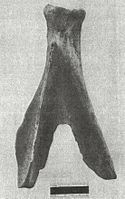 |
3 | Farming, gardening, or general digging | Common at Huber and Oneota sites. Sometimes made with bison scapula further west. They might have been used to dig the pits found at Moccasin Bluff. |
| Bone | Unmodified turtle carapace, Common Box Turtle, possibly used as bowl | 2 | Used as a bowl for tobacco, food, or general storage | Using a turtle shell as a tobacco tray has been recorded among historic Central Algonkian tribes. | |
| Bone | Bone rasp (musical instrument) fragment |  |
1 | Entertainment or use in ceremonies | Also found at Huber, Whittlesey, and Fort Ancient sites. |
| Bone | Grooved bone |  |
1 | Unknown use | Not common in this area; reported at the South Park site in northern Ohio and the Walker-Hooper Site in Wisconsin. |
| Bone | Unmodified deer mandibles (jawbones) | "unusually large numbers" | Scraping maize (corn) kernels off the cobs | The report doesn't say if they show wear from use, but their large number suggests they were tools. At other sites, they indicate corn farming. | |
| Stone | Pipe bowl fragments; stemless, vase- or bowl-shaped pipe | 2 | Smoking pipes for fun or ceremonies | Historic tribes used stemless pipes for recreational smoking, while ceremonial pipes had stems. | |
| Stone | Unfinished pipe bowl fragments; stemless, block type | 2 | Smoking pipes for fun or ceremonies | Block-style pipes are known from Whittlesey and Fort Ancient sites in Ohio. | |
| Clay | Pipe fragments; modified tube-shaped | 2 | Smoking pipes for fun or ceremonies | This type is known from sites in Wisconsin. |
Ancient Pottery: Clues to Cultures
Archaeologists often find pottery very helpful for understanding ancient cultures. Pottery is usually plentiful at a site. The way it was made and decorated can tell us a lot about the time period, location, and culture of the people who made it.
Middle Woodland Pottery (c. 100 BC-500 AD)
The 1948 digs found 20 pots from the Havana Ware pottery type. The Havana Culture was a local version of the larger Middle Woodland period. This period was known for large burial mounds, unique pottery, ceremonial practices, farming, and wide trade networks.
Late Woodland and Upper Mississippian Pottery (c. 500 AD-1500 AD)
During the Late Woodland period in the Great Lakes region, maize agriculture became common. This led to more food and bigger populations. More people sometimes meant more competition and warfare. After 1000 AD, cultures from the Mississippi River Valley had more influence. This led to the creation of Upper Mississippian cultures in the Great Lakes area.
By studying the Late Woodland / Upper Mississippian pottery from the 1948 digs, archaeologists identified two main types:
- Moccasin Bluff Ware: (327 pots) This pottery used grit (small bits of rock) to make it stronger.
- Berrien Ware: (48 pots) This pottery used crushed shell to make it stronger.
Moccasin Bluff Ware (327 pots)
Moccasin Bluff Ware is divided into several types, each with its own features:
- Moccasin Bluff Cordmarked (97 pots): This pottery has a cord marked surface. It belongs to the Late Woodland period.
- Moccasin Bluff Collared (14 pots): This pottery has thickened or "collared" rims. It's from the Late Woodland period.
- Moccasin Bluff Modified Lip (57 pots): This type has unique rim and lip designs. It's from the Late Woodland period.
- Moccasin Bluff Impressed Exterior Lip (56 pots): This pottery also has special rim and lip designs. It's from the Late Woodland period.
- Moccasin Bluff Plain (37 pots): This pottery has a smooth, plain surface. It's from the Late Woodland period.
- Moccasin Bluff Plain Modified Lip (36 pots): This type has unique notches or finger marks on the rim, with a smooth outside. Similar pottery has been found at other sites like Dumaw Creek and Summer Island, which might be Prehistoric Potawatomi sites. It dates from the late Prehistoric to early Historic times, possibly linked to the Potawatomi.
- Moccasin Bluff Notched Applique Strip (20 pots): This pottery has a thickened rim with designs added on top. It dates from the late Prehistoric to early Historic times.
- Moccasin Bluff Scalloped (10 pots): This pottery has a wavy or "scalloped" rim edge. Similar pottery from other western Michigan sites suggests it might have been made by the Potawatomi. It dates from the late Prehistoric to early Historic times, possibly linked to the Potawatomi.
Berrien Ware (48 pots)
The shell-tempered Berrien Ware found at the site is divided into five groups. These groups can be linked to two known Upper Mississippian cultures:
- Berrien Ware Subgroups 1, 2, and 3: These are like Huber ware, which is known for its shell-tempered smooth surfaces. It's either plain or has lines scratched into the shoulder area. The Huber culture was mainly around the Chicago area and is related to the Oneota culture in Wisconsin. It dates from the late Prehistoric to early Historic period (c. A.D. 1400-A.D. 1650), sometimes found with European trade goods. The historic tribe behind Huber pottery isn't certain, but early French explorers noted the Miami tribe lived around the southern shore of Lake Michigan during this time. Small "toy" pots were also found, possibly made by children learning pottery. This pottery is from the late Prehistoric to early Historic period, possibly linked to the Miami.
- Berrien Ware Subgroups 4 and 5: These are like Fisher ware, first found at the Fisher Mound site in Illinois. Fisher pottery also uses shell tempering, often has cordmarked surfaces, and scratched or incised decorations. Notched lips are common. Fisher and Huber cultures sometimes lived in the same areas, like Chicago and northwest Indiana. The Fisher pottery at Moccasin Bluff is similar to types found at the Fifield site in Indiana. Unlike Huber Ware, Fisher has not been found with European trade goods, so it's thought to be a bit older. This pottery is from the Prehistoric period, linked to the Upper Mississippian Fisher culture.
Proposed Timeline of Late Prehistoric Cultures
The large amount of pottery found at Moccasin Bluff, along with comparisons to other sites, helped researchers create a timeline for Late Woodland cultures in western Michigan and northwest Indiana.
| Phase | Date Range | What Was Found |
|---|---|---|
| Brems Phase | c. 500-1050 A.D. | Pottery types: Moccasin Bluff Modified Lip and Moccasin Bluff Collared. |
| Moccasin Bluff Phase | c. 1050-1400 A.D. | Pottery types: Moccasin Bluff Impressed Exterior Lip, Berrien Ware Subgroups 4-5 (Fisher Ware). |
| Berrien Phase | c. 1400-1650 or first European contact | Pottery types: Berrien Ware Subgroups 1-3 (Huber Ware), Moccasin Bluff Plain Modified Lip, Moccasin Bluff Notched Applique Strip, and Moccasin Bluff Scalloped. This phase has been dated by radiocarbon dates of A.D. 1590 and A.D. 1640. |
The Berrien Phase ends when Prehistory turns into the Historic period. Researchers think Berrien-Huber ware might be linked to the historic Miami tribe. Moccasin Bluff Scalloped pottery might be from an Algonquian-speaking tribe like the Potawatomi. Moccasin Bluff Notched Applique Strip pottery might be from Ohio tribes who moved because of the Iroquois Wars. Since Michigan was traditionally the home of the Potawatomi, other researchers also suggest the Berrien Phase represents the Potawatomi culture.
Interestingly, no European trade goods were found in the Berrien Phase at Moccasin Bluff. This means the site was abandoned right at or just before Europeans arrived. The same is true for a nearby site called Schwerdt. One reason for this might be that the Potawatomi were forced to leave western Michigan during the Iroquois Wars. They moved to the west side of Lake Michigan in Wisconsin. This left the lower part of Michigan mostly empty for several decades.
New Discoveries from the 2002 Digs
More excavations were done in 2002 to learn more about how people got their food and how the site was used. More Moccasin Bluff Ware pottery was found, including Moccasin Bluff Plain Modified Lip, Moccasin Bluff Impressed Exterior Lip, Moccasin Bluff Scalloped, Moccasin Bluff Cordmarked, and Moccasin Bluff Plain. They also found pottery from the Middle Woodland period and a partially rebuilt pot from the Early Woodland period, which was not well represented in the 1948 digs.
The 2002 excavations used a special technique called flotation. This helps recover tiny plant remains that were missed before. As a result, many small seeds and fruit seeds were found. The fruits included pin cherry, pokeberry, grape, and blackberry/raspberry. The seeds included several starchy and oily native seeds like goosefoot, maygrass, knotweed, amaranth, sumpweed, and sunflower. These seeds are part of the Eastern Agricultural Complex. These are plants that ancient people grew or semi-grew, in addition to well-known crops like maize, beans, and squash. These tiny seeds are usually only found when flotation is used.
How Was Moccasin Bluff Used?
The findings from Moccasin Bluff suggest that people lived at the site for most or all of the year:
- Corn (Maize): Corn was found, meaning it was planted in spring and harvested in fall. Many deer jawbones were also found, suggesting corn was processed here.
- Fish: Sturgeon fish spawn in the spring, which means people were there in the spring.
- Nuts: Nutshells were present, indicating people were there in the fall.
- Deer: Deer can be hunted year-round, but they are heaviest and have thickest coats in the fall. Early historic Native American tribes often had a big fall deer hunt.
- Storage: Many storage pits were found, which means food was stored for the winter.
Based on the excavations and information from early historic Native American tribes, researchers first thought Moccasin Bluff was a permanent or semi-permanent village. Other sites, like Schwerdt, might have been temporary camps for seasonal hunting or gathering. No structures were reported at Moccasin Bluff, but researchers believed the part with houses was destroyed by highway construction.
However, the 2002 excavations found no more evidence of maize and still no signs of structures. This has made some archaeologists rethink the idea of it being a farming village. Since there aren't many known Late Woodland or Upper Mississippian farming villages in western Michigan, some researchers now suggest that the people living here might have had a more balanced way of life. They might have relied on hunting, fishing, and gathering, along with limited farming of Eastern Agricultural Complex seeds and corn.




